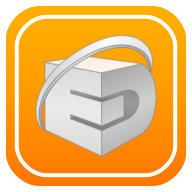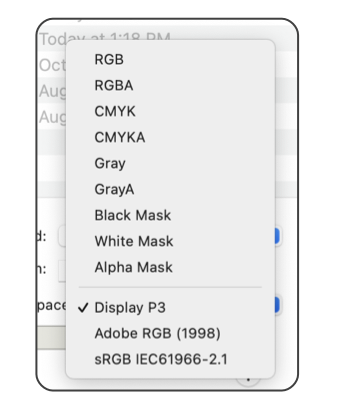


|

|
|
TIFF - Export Tag Image File Format (TIFF) is perhaps the most versatile bitmap format. It is used for data storage and interchange. It can be viewed on almost any computer or by any computer application. The parameters found at the bottom of the Export Panel (shown above) are used to export TIFF files. The Dots Per Inch (DPI) parameter is used to define the resolution or quality of the exported representation. Normal display screen viewing requires about 72 DPI for acceptable visual quality. Printed applications usually require 300 DPI for good quality representation. High quality printed results may need 600 DPI or greater. The size of an uncompressed TIFF bitmap depends directly on the imaged area, with color depth as a third dimension. It grows rapidly (square law) as the DPI is increased. 2400 DPI may be prohibitively large even for small drawings. The practical limit for an 8 inch by 8 inch drawing is 1600 dpi, there are limits internal to macOS that limit an off screen bitmap to 16,000 pixels by 16,000 pixels. Keep in mind that we cannot regenerate an EazyDraw vector representation from a TIFF export file. If your final work needs to be TIFF (or any other bitmap format) be sure to save and archive the EazyDraw original in case modifications to the work are needed in the future. You can always generate a revised TIFF export from the original-but the reverse is not possible.

Proper selection of the correct export parameters depends on the ultimate use of the exported file. It is usually best to determine settings by experimenting, possibly with small test files. EazyDraw uses vectors to define all graphics. A vector representation does not need to record each dot along a curve. For example only 4 dots are needed for a full Bezier curve segment. The size of a vector representation is driven by the amount of content, not size and detail. A small icon containing numerous curves, colors and shading can result in a very large vector based representation. The TIFF representation of this example would require only a small file at 72 DPI. These are the trade-offs that are important, especially if the work product is intended for communication over networks or the internet. With no compression a bitmap file’s size does not depend on content, a 5 page blank document (with a border) is the same size as a 5 page brochure packed with curves, special effects, and text. If the bitmap is visually sparse, compression may provide significant file size reduction. If the bitmap is rich in detail, colors, and shades loss less compression may not significantly reduce the size. The compressions presented here are loss-less, they do not degrade or remove information from the bitmap. However, that doesn't mean the full quality of the vector derived original is preserved-just the quality of the defined bitmap. The JPG format provides lossy compression of TIFF bitmaps. You may generally be certain that any recipient will be able to view TIFF graphics. If the recipient is using Mac OSX they may download the EazyDraw reader to view and interact with your original work in the native EazyDraw vector form. The Antialias check box selects the use of macOS’s antialiasing algorithms during preparation of the image. In some cases it may be best not to use this capability. If antialiasing is used when viewing the image, it would be applied twice. If you need exact control over the color of each pixel be sure to turn off antialiasing as it will modify individual pixel color on color contrast borders. Interpolation is applied to Bezier paths during preparation of the image. This normally has little affect on the image. If exact control over placement of pixels of lines and curves is needed select no interpolation. There are 3 levels and an automatic selection. When designing graphics with a transparent background it can be confusing if included graphic elements have a solid white (non-transparent) background. In these situations designers will often set a distinct background (like the "green screen" in television production) color for the drawing. This is set on the Page Layout panel. Then when exporting to produce the product graphic, choose "No Background" for the Background setting on this panel. |